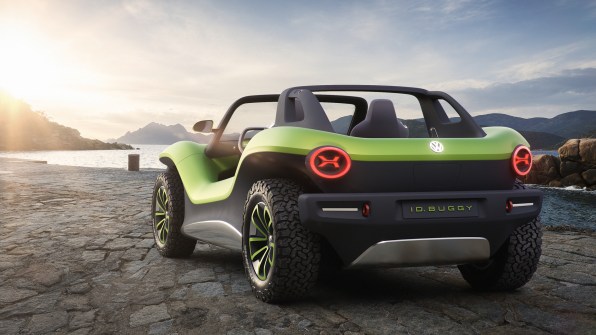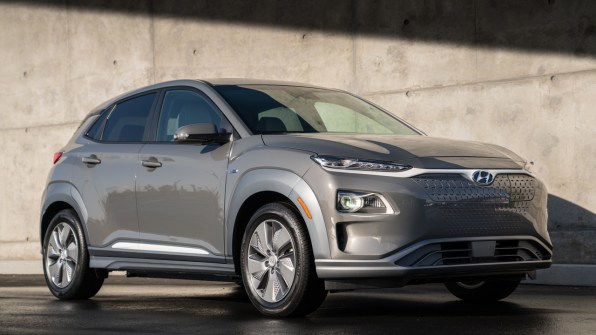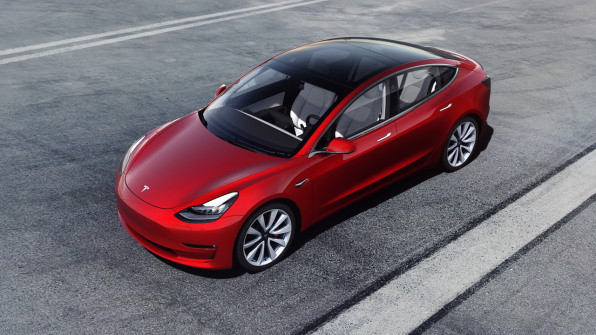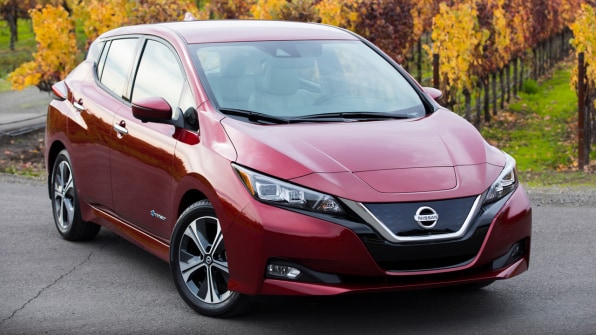
The real reason you probably won’t buy an electric car this year
There are more models of electric cars available on the market from more manufacturers than ever before–and car design is the most radical it’s been in decades. So what’s the holdup?
After decades of will-they-won’t-they, electric cars finally seem to be having their moment. Beyond the ever-growing lineup from Tesla–which is expected to launch a sub-$40,000 electric SUV this week–Hyundai, Kia, and Audi have all committed to releasing new electric vehicles this year.
There are more models of electric cars available on the market from more manufacturers than ever before–and car design is the most radical it’s been in decades. At last, the leap to electrification feels inevitable. But that doesn’t mean the work is done. Electric cars still face a slew of challenges, ranging from their design, to their perception, to their production. I spoke to Chelsea Sexton–a consultant and EV advocate who worked at GM during its self-destructed electric car pushin the late ’90s–about why the electric spike may be a bit further off than we think.

FIRST, THE GOOD NEWS
By all means, electric vehicles are making huge strides, for all sorts of reasons. Most of all, the cars are just better than they used to be.
“The vehicles themselves are becoming more compelling,” says Sexton. “They’re getting larger, the range is getting better. And they’re landing at the average car price in this country–$35,000.” That’s largely thanks to declining battery prices, which dropped 50% in a period of three years.
The Hyundai Kona electric is perhaps the best articulation of these converging trends. It’s a relatively typical-looking crossover (or small SUV) that would blend in with any other on the street. Starting at $36,450, and at dealers now, it that has 258 miles of range per charge. (The world’s first electric car, 1996 GM EV1, a two-seater that got 70-100 miles per charge–meaning range has doubled to quadrupled over two decades, and for a larger, family vehicle.)
It’s impossible to understand how important models like the Kona are to the industry without understanding how people buy cars today. In short, not as many people in the U.S. buy sedans as other vehicles. We live in the age of the crossover, which along with trucks, outsell sedans by roughly 2:1.

So if you want to sell an electric vehicle today, it should be a crossover. Case in point: Teslas already outsell all luxury sedans, even gas sedans, by an embarrassing margin, but the brand is only beating sedans. Tesla sold 25,000 of its budget, Model 3 car in December 2018. That same month, Nissan, Toyota, and Honda each sold roughly 40,000Rogues, Rav4s, and CR-Vs, respectively.
Thus far, electric crossovers have been fairly elusive, let alone affordableelectric crossovers. Tesla’s Model X crossover is its most expensive vehicle, with an MSRP that starts over $80,000.
In this regard, cars like the electric Kona are potentially game-changing. Elon Musk’s obsession with a true $35,000 Tesla Model 3–a benchmark the company was just able to hit this month–makes a lot of sense, too, when you realize he’s been trying to limbo Teslas into mainstream car-spending habits. It makes even more sense when you consider Tesla’s next move, the Model Y, expected to be announced soon. It’s a Model 3 turned into a crossover, which Musk has said will be about 10% bigger and 10% more expensive than a Model 3.
We don’t quite have a $35,000 electric crossover, yet, but we’re only a few thousand dollars away from getting there.

CARS ARE STILL ENGINEERED AROUND RANGE ANXIETY
So if electric crossovers are cheap enough and big enough, will Americans buy them? There’s still a big catch. “Range anxiety has always been a thing, so to speak. Surveys and data continue to show that,” says Sexton. “Ask someone in Kansas, and they say, we need 300-400 miles–and it has to charge in five minutes!”
Sexton’s point is a bit of an exaggeration, but not entirely. Range anxiety (the concern that your car will run out of electricity on the road) and price continue to be the two biggest barriers to buying an EV. And many would argue that the way the auto industry has traditionally addressed range anxiety–by releasing hybrid cars that have gas engines at the cost of smaller battery capacity–was like cutting off one’s nose to spite their face. Yes, adding a gas engine means you’ll never be stuck on a road trip with an empty battery. But it also means your battery might supply all of 20 miles of charge in the first place. Gas engine backup, in some ways, only works to reinforce the fear of driving a fully electric vehicle, making its range feel more finite.
For most people in the United States, the fully electric cars of today fit range needs by a long shot. The average person commutes well under 10 miles to work–even if that commute takes an average of 52 minutes a day. Sexton argues that this creates a difference between our perceived needs and our real needs. We spend a lot of time in the car each day–and commute times get worse each year–so we naturally assume we drive a lot of miles. In reality, we don’t. And even when we’re not driving to work, the average trip is still only six miles.
This isn’t to say our habits don’t need to change; they do. People do need to figure out how they’ll charge their vehicles–especially if they don’t have a garage, as 80% of charging happens at home. Midwest winters can take a major toll on batteries, too, reducing range by as much as 40% according to AAA. (Not only does cold weather decrease battery capacity, the car’s cabin heat drains the battery, too.) Cross-country trips also require planning, but a nationwide network of highway charging stations will be complete by 2019 that should make the task easier.
In any case, people do adjust to owning EVs, and quickly. Sexton cites a Nissan study presented at a conference, surveying new buyers of its electric Leaf. It showed that after 10 days, the average new EV owner’s range anxiety disappears. And this study surveyed a Leaf with an 80-mile range, or about one third the range of modern EVs. A separate German study, with participants driving an electric Mini Cooper with a 100-mile range, found that range anxiety disappeared after three months.
“Our smartphones don’t have the quality of a landline, and they don’t have the talk time,” Sexton says. “But they do so many other things better that we don’t care. This is a similar kind of thing. We’re used to past capability and what that looks like.”

BIG AUTO REFUSES TO CREATE ITS OWN DEMAND
“If you build it, they will come.” “If I gave the public what they asked for, I would have built a faster horse.” Both of these statements are technically fictions, but they illustrate an important idea in disruptive economics: Demand can’t always drive supply, because people can’t buy what doesn’t exist. Sometimes supply does drive demand. Nobody could have asked for an iPhone before Apple invented the thing. So it is with electric cars.
“[EVs are] the only example in the history of the automotive industry, if not all retail in general, that the industry side has demanded that demand predate and continue to exceed supply,” says Sexton. “The core automotive industry has always been, and on average remains, really ambivalent about [electric vehicles]. On one hand they’re preparing for it. They see it as sort of inevitable because of regulations they have to meet. But if given a path out tomorrow, they’d totally take it.”
Why? Beyond Tesla, which built a business around EVs, auto manufacturers have optimized themselves over a century to build gasoline cars. And gas cars have twice the profit margin of electric cars–or at least they do today. In theory, electric vehicles could one day be cheaper in that they require less parts. It also helps that automakers are taking important steps to drive down part prices and increase scale. Ford has teamed up with VW to share parts and technologies–possibly for EVs–and Renault-Nissan-Mitsubishi have an electric alliance of their own. But getting to the point where profits are on par with those of gas cars could take several years, and it comes at the cost of the bottom line in the short term.
That’s why when I share my excitement for all the new electric car models coming to market this year and next, Sexton urges a more tempered enthusiasm. She suggests that while these cars will come to market, they will be in limited numbers, and with limited promotion, especially in the United States.
“Many car companies are taking the approach, ‘We’ll sell as many as we need to,’” says Sexton. “But these aren’t wildly profitable cars for them right now, and so they don’t want to sell as many as they possibly can.”
Reaching out to several auto manufacturers to confirm their production of EVs over the next two years, no company would comment on near-future inventories of their electric cars–including Audi, GM, Nissan, Toyota, and VW. But VW said it hoped to be the world’s leader in pure electric vehicles (not hybrids) by 2025, by which time it plans to produce more than a million electric models a year. Nissan shared that 23,903 Leaf vehicles were produced for the U.S. in 2018–putting the Leaf on par with other premium sedan sales, but representing a little more than 1/20th of the Rogues it sold over the same time. (It should be noted that the Leaf is the best-selling EV of all time, having just announced 400,000 sales worldwide since its 2010 debut.)
A LACK OF INCENTIVE IN THE U.S.
For the most part, auto manufacturers simply lack the incentive of curing range anxiety, or racing to the bottom of pricing, to truly sell customers on electric cars. So what drives EVs? Legislation.
Across Europe, policies from CO2 emissions regulations, to tax breaks, to mandatory charging stations–along with, sure, the reality of the higher price of gas in the first place–are driving a faster adoption of EVs in overall sales volume, including many models of which don’t even actually go on sale in the United States at all, or in highly limited numbers.
“The Mitsubishi plug-in hybrid is one of the best-selling cars around the world. It came to the U.S. dead last,” Sexton says, referencing how long it took to the vehicle to reach the second largest auto market on the planet. “Mitsubishi Canada sold more than the U.S. did.”
And that’s the long and short of the problem facing electric car adoption in the U.S. Faced with a country of people scared of electric cars, without reliable financial or governmental incentives to clean up their act, why would the car companies want to do anything but sell us more gas?
“Especially in this country, with this administration, it’s difficult . . . ” says Sexton.














